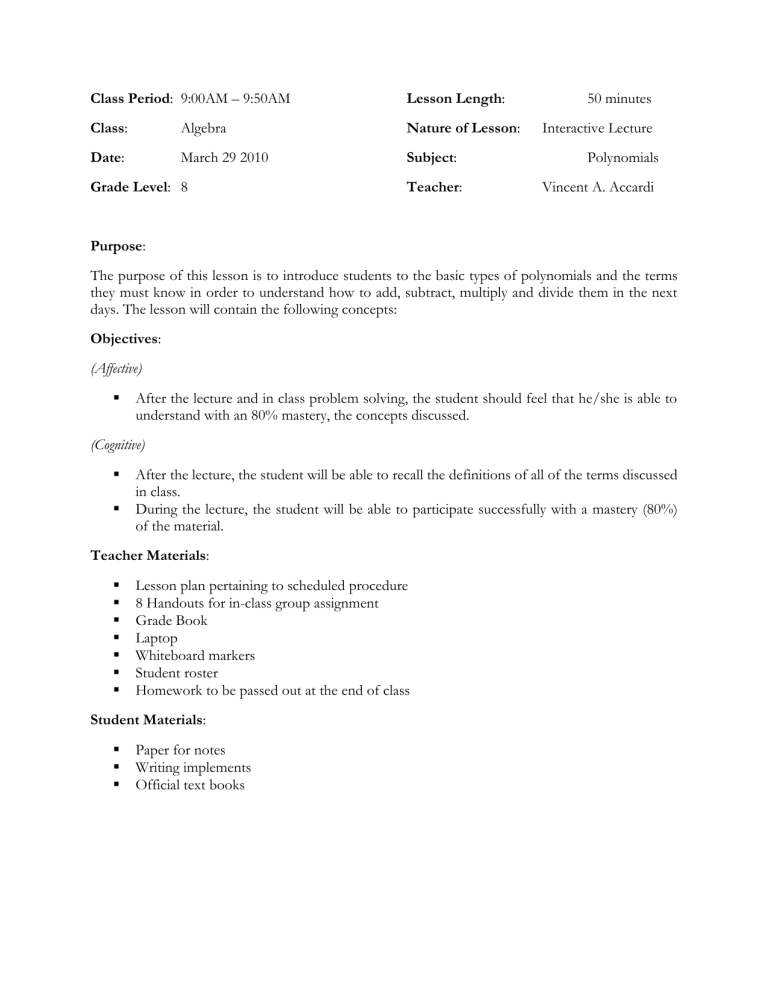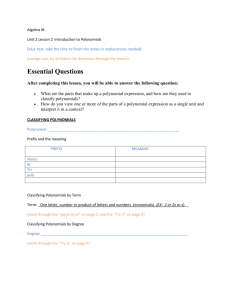UNIT 3 mon - math

Class Period: 9:00AM – 9:50AM
Class: Algebra
Lesson Length: 50 minutes
Nature of Lesson: Interactive Lecture
Date: March 29 2010
Grade Level: 8
Purpose:
Subject:
Teacher:
Polynomials
Vincent A. Accardi
The purpose of this lesson is to introduce students to the basic types of polynomials and the terms they must know in order to understand how to add, subtract, multiply and divide them in the next days. The lesson will contain the following concepts:
Objectives:
(Affective)
After the lecture and in class problem solving, the student should feel that he/she is able to understand with an 80% mastery, the concepts discussed.
(Cognitive)
After the lecture, the student will be able to recall the definitions of all of the terms discussed in class.
During the lecture, the student will be able to participate successfully with a mastery (80%) of the material.
Teacher Materials:
Lesson plan pertaining to scheduled procedure
8 Handouts for in-class group assignment
Grade Book
Laptop
Whiteboard markers
Student roster
Homework to be passed out at the end of class
Student Materials:
Paper for notes
Writing implements
Official text books
Sunshine State Standards:
MA.912.A.4.2
Polynomials - Perform operations on polynomials. Find factors of polynomials, learning special techniques for factoring quadratics. Understand the relationships among the solutions of polynomial equations, the zeros of a polynomial function, the x-intercepts of a graph, and the factors of a polynomial.
Procedures:
1.
Pre-Class a.
Clean the whiteboard b.
Connect laptop power and internet. c.
Write the day’s plan on the board (learning objectives and concepts) d.
Draw a very simple polynomial on the whiteboard. i.
X 2 - 4x + 1
2.
Introduction (10 minutes) a.
Warmly welcome the students in i.
Ask about the weekend and anything relevant to keep them relaxed b.
Scheme Activation i.
Ask the students what they know about polynomials
1.
Ask them if they know the structure, what they can look like on a graph, or what their specific function may be. ii.
Define polynomial.
1.
A mathematical function that is the sum of a number of terms. a.
“Even though the word may be foreign to you, it is actually a simple concept; a combination of two or more numbers of terms. iii.
“Think of the significance of polynomials and what makes them different from what we have learned previously, as we continue the lecture.”
3.
Activity One (8 minutes) a.
Whiteboard – Explain the specific properties of a polynomial, and how the terms relate to the problem.
1.
Ax^2 + bx + c
2.
If f(x) is a polynomial, it's leading term (A) will determine the behavior of the graph on the far right and far left.
3.
The Leading Term Test
4.
The Leading Coefficient Test.
5.
If f(x) is a polynomial with degree n, then there is at least 1 complex zero x=c ii.
Make sure to note that the letters in a polynomial simply stand for an unknown variable. iii.
Fast Assessment : Ask the students easy questions right off the bat, so they can comprehend the foundation of the material. iv.
ESOL Accommodation : Be prepared to go over topics more than once that one or more students ask to be re-stated. Information may have been poorly comprehended, or not properly explained.
4.
Activity Two (8 minutes) a.
Whiteboard – Explain how to write a polynomial, and how to break down the meaning. i.
Write X 2 - 4x + 1 on the board and solve for X.
1.
“The X stands for one value. For example, if we plug in the number
3 for the value of X, we can solve the polynomial. (3) 2 – 4(3) + 1 … 9
– 12 + 1 … Y = -2
ii.
Quick Assessment : Write a different, but equally simple polynomial on the board. Write it large enough and have the students work silently to evaluate the expression, with a given number for an X value. iii.
ESOL Accommodation : Be sure to be aware of any misunderstanding on an
ESOL student’s part. For reassurance and guaranteed understanding of the task at hand, be prepared to give personal attention to ensure comprehension.
5.
Activity Three (15 minutes) a.
Separate students into evenly numbered groups. i.
Groups of three, four or five. b.
ESOL Accommodation : ESOL students should be spread out between all groups evenly. Also, if available, pair a level 3 ELL with a level 1. c.
Group Activity – Working together to evaluate polynomials. i.
Once the groups are set up and spread out, pass out a handout to each of the groups.
1.
“Each handout has eight polynomials that must be evaluated by the group. The respective X value is located right next to the expression in question. Good luck!” ii.
Students should work together in their groups to identify the polynomials. iii.
Students have a 10 minute time frame to complete the task d.
Quick Assessment : After 10-12 minutes (or earlier depending upon when most groups appear complete), we will go over the answers as a class. Group members will answer as a group. i.
Groups should be encouraged to help one another (politely) if the answer is incorrect.
6.
Conclusion (remaining minutes) a.
Whiteboard – Go over the day’s agenda to make sure all material has been aptly covered. i.
“What did you learn today that you hadn’t already known?” ii.
“How will knowing how to evaluate polynomials singularly help us later on in the unit?” b.
“Are there any more questions regarding the material?” c.
Pass out homework (See Attached.)
7.
Post-Class a.
Be prepared to answer more detailed questions, as well as questions that may have been misinterpreted during the class. b.
Clean the whiteboard and disconnect computer. c.
Clean room i.
Push in chairs, pick up loose garbage.
Homework:
Have the students evaluate ten polynomials in a handout given in class, and have them be ready to explain how they came up with the answer.
Formal Assessment:
The students will complete the evaluation of ten polynomials on a spate sheet of paper. When class begins the next day, we will go over the polynomials before we begin the new section.
ESOL Accommodation : The material requires little English comprehension, so no specific accommodations will be made. However, if the student cannot understand the directions, they should seek help before the class period ends.
Notes to Myself:
Speak slowly and clearly
Use examples that are unmistakable and very clear
Continually make sure that students are not falling behinds. Be aware of any latent confusion to the best of my ability.
Reflections:
______________________________________________________________________________
______________________________________________________________________________
______________________________________________________________________________
______________________________________________________________________________
______________________________________________________________________________
______________________________________________________________________________
______________________________________________________________________________
______________________________________________________________________________
______________________________________________________________________________
______________________________________________________________________________
______________________________________________________________________________
_____________________________________________________________________
Homework
Directions: Evaluate each polynomial Name _____________________
1. X2 – 5x + 7 X = 4
2. X2 – 7x + 1 X = 3
3. X2 – 2x + 14 X = -5
Etc…
In- Class Handout
Directions: Work in groups to evaluate the problems
1. X2 – 3x + 2 X = 5
2. X2 – 6x + 2 X = 9
3. X2 – 9x X = 2
Etc…








